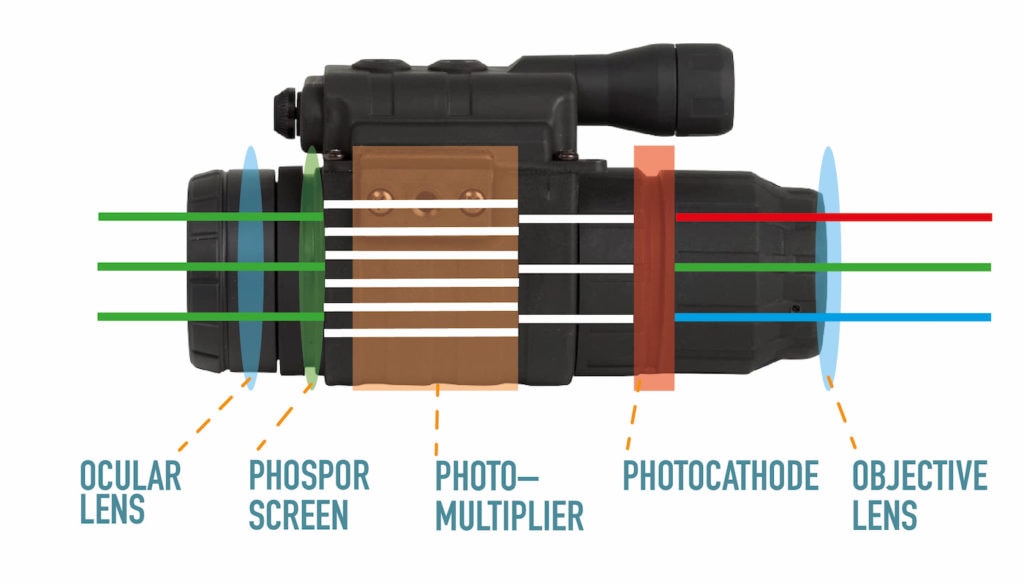6 Different Types of Binoculars & Their Uses (with Pictures)
Last Updated on

Whether you’re a first-time buyer or looking for your next set of binoculars, you’re going to need to do a bit of research — and we’re not just talking about magnification strength or size.
There are actually many different types of binoculars and choosing the right one starts with knowing what’s actually available. Can you name all of the different types? What about what each type is best for?
If not, don’t worry because we’ve got you covered. In this article, we’ll go over six of the most common types of binos, the pros and cons of each, what they’re ideal for, and some other features you should look for when shopping for your next set.
6 Different Types of Binoculars
1. Roof Prism Binoculars
When breaking down binocular types, there are two main categories for modern styles: Roof prism and Porro prism.

Roof prism binoculars are actually the more modern of the two. They’re streamlined, straight-tubed, more lightweight, and more compact than the older-styled Porro prism binoculars. At first glance, they seem to be a much more simplified version of traditional (Porro) binos. However, they are anything but.

While on the outside they are simplistic, inside this type of binocular has a much more complex machination than any other style. When the light from your target enters the objective lenses, it gets bounced around a series of convoluted pathways before reaching your eyes at the ocular lenses. Through this sequence, roof prism binos can actually produce a much higher magnification power and brighter end imagery.
However, their complex internals can make these binos a bit more expensive than others. They cost more to make, which the manufacturer then passes to the consumer.
Pros & Cons of Roof Prism Binoculars
- Lightweight
- Compact
- Higher magnification
- Clearer imaging
- Much more expensive
- Some models have a narrow field of view
2. Porro Prism Binoculars
The next major binocular type is Porro prism binoculars. These are actually the original style of bino sets. First developed in the 19th century by Ignazio Porro, this design produced the first real sets of modern binoculars and is still in use today.
The Porro prism concept works by sending the light from your objective lenses through an interdependent pair of triangular light-catchers in a quick horizontal jag. This movement then amplifies and inverts the light to give you a sharp, magnified image of your target.

This zigzag design makes the binos a bit more cumbersome and unwieldy than the roof prism style. However, this very design mechanism does have its merits. Porro binos often provide a clearer, more three-dimensional image than roof prisms. Also, they normally provide a greater field of view than the straight-tubed roof style binos. And they’re actually simpler in design and, therefore, much cheaper to produce.
Pros & Cons of Porro Prism Binoculars
- Many affordable options
- Good 3D imaging
- Wide field of view
- Bulky and heavy
- Lower magnification
3. Night Vision Binoculars
A standard set of binoculars are going to be next to useless for you if you’re needing them in nighttime or low-light situations. In these cases, you may want to consider a pair of night vision binos.

Night vision devices (such as binoculars) are electronically assisted optics that take the little available light you have and amplify it through a series of photon-enhancing components. At the end of this process, your eyes are treated with usable imagery to help you navigate the dark.

Pros & Cons of Night Vision Binoculars
- Allows you to see in the dark!
- Pricey
- Very fragile
4. Marine Binoculars
Marine binoculars are a specific binocular type designed to be in and around water. They have a wider ocular and objective lens with low to moderate magnification power. When on the high seas (or just whale watching), you’re going to want something that has a larger field of view with a lower magnification.

Too high of magnification will cause a shaky image with just the slightest hand movement. Imagine how hard it would be to keep stable on a rocking boat! Marine binoculars are also generally fog and waterproof. And depending on the model, they may be just as useful under the waves as they are on the surface.
Pros & Cons of Marine Binoculars
- Rugged with rubberized armor coating
- Waterproof
- Fog proof
- More expensive than regular binos
- Can get lost easily if not equipped with a flotation strap
5. Astronomy Binoculars
If you’re an avid stargazer or amateur astronomer, you’re definitely going to want a pair of binoculars designed specifically to explore the heavens. Sure, a telescope is great, but there are times when one just isn’t on-hand or feasible.
For example, let’s say you’re out camping, trying to catch the latest meteor shower. It’s awfully difficult to trace quick-moving meteors or other heavenly bodies on a telescope. But with a little practice, you’ll be a master at detecting and viewing nighttime objects with a good set of astronomy binoculars.
Now, when it comes to this type, there are wildly different variations. There are some that easily fit in your pocket for spur of the moment views. And there are some that actually require a tripod similar to a telescope. These larger models are very costly and cumbersome; however, their dual ocular lenses give you a much larger field of view than a standard telescope.
Pros & Cons of Astronomy Binoculars
- More portable than a telescope
- Come in a variety of sizes and magnification strengths
- Higher-end models are extremely pricey
- May require a tripod
6. Opera Glasses
When you think of binoculars, these are probably the last thing that come to mind. But they’ve been around almost as long as modern binoculars have! And quite frankly, they’re normally the most stylish sets around.
These are primarily used for watching theater productions or opera and musical performances. It can be difficult to catch all of the nuances that actors and musicians put into their craft. But these specifically designed binoculars will help you catch even the most subtle of movements.

They do not come in super-high magnification powers with the highest powers often being a 4x magnification. But that’s more than enough for what they’re used for. Plus, the low powers make them super easy on your eyes, so fatigue will be at a minimum even through extended periods of time.
Pros & Cons of Opera Glasses
- Low magnification powers for maximum viewing pleasure and minimal eye fatigue
- Very stylish
- Relatively inexpensive
- Niche product
Other Features to Consider When Comparing Binoculars
Finding the perfect set of binoculars can be a bit more challenging than you’d first think. Not only do you need to determine what type of binos are best for your situation, but you also need to understand what features you’ll need.
For example, we highly doubt you’ll need a set of waterproof opera glasses. But waterproofing may come in handy for those that may be caught in the rain hiking, hunting, or birding.
So, let’s jump into some additional features that you may want to consider for your next pair of binos.
Additional Categories of Binoculars
Foldable or Mini Binoculars
If you’re always using your binoculars on the go, you should look into a good set of folding binoculars. Binos can be large and clunky — especially Porro prism style sets. However, a pair of foldable binoculars actually helps to minimize the awkward carry.

Wide Angle Binoculars
Wide angle binos definitely have their uses. As a matter of fact, most birders actually prefer a wide-angle view. It makes finding that elusive songbird that much easier. They provide the largest field of view out of any binocular type and come in both roof or Porro prism designs.

Zoom Binoculars
Zoom binoculars are a very controversial topic when it comes to binos. That’s because zoom binoculars, although useful in many situations, actually distort and limit your field of view. They’re decent for honing in on particular objects after scouting; however, you’ll lose some of the surrounding environment when zooming in.

High-powered Binoculars
You may want to consider high-powered binoculars if you’ll be looking at things from extreme distances. For example, if you like to search through your urban landscape from the sanctity of your building’s rooftop or love stargazing, high-powered binoculars could be something you’d enjoy.

Focus Free Binoculars
This is a great binocular type for those just starting with optics or for children. There’s no need to focus on these binoculars at all when using them. And that’s because they are inherently designed to be fixed at certain ranges. These binoculars often work best at medium distances.

Image Stabilizing Binoculars
Image-stabilized binoculars eliminate second-guessing and reduce the effects of human error aka “image shake”. These are binoculars for active situations where movement is necessary, such as birdwatching or viewing a football game. These are also some of the most expensive specs in the genre.

Waterproof Binoculars
In our opinion, if you’re going to be outdoors with your binoculars, you need to at least consider waterproofing. You never know when a freak shower or rainstorm will appear, and it’s best that your binos stay safe. You might not need binoculars that can be taken underwater to great depths, but rubberized seals and tight lenses are always a sound choice.

Tripod-mounted Binoculars
Tripod-mounted binoculars often go hand-in-hand with higher-powered binoculars. Due to their high magnification power, the images produced can become extremely shaky with even the slightest of movements. Mounting your binos on a tripod, however, helps to eliminate this problem altogether, not to mention keeping them safe from a drop.

The List Goes On…
People use binoculars for so many reasons that there are infinite styles to match your needs or personality. From waterproofing, fog proofing, infrared, lens sizes, magnification strength, coatings, prism types, size, and armor, the possibility of finding a perfect pair of binoculars is endless.
Featured Image Credit By 2078645, Pixabay
Table of Contents
- 6 Different Types of Binoculars
- 1. Roof Prism Binoculars
- Pros & Cons of Roof Prism Binoculars
- 2. Porro Prism Binoculars
- Pros & Cons of Porro Prism Binoculars
- 3. Night Vision Binoculars
- Pros & Cons of Night Vision Binoculars
- 4. Marine Binoculars
- Pros & Cons of Marine Binoculars
- 5. Astronomy Binoculars
- Pros & Cons of Astronomy Binoculars
- 6. Opera Glasses
- Pros & Cons of Opera Glasses
- Other Features to Consider When Comparing Binoculars
- The List Goes On…
About the Author Robert Sparks
Robert’s obsession with all things optical started early in life, when his optician father would bring home prototypes for Robert to play with. Nowadays, Robert is dedicated to helping others find the right optics for their needs. His hobbies include astronomy, astrophysics, and model building. Originally from Newark, NJ, he resides in Santa Fe, New Mexico, where the nighttime skies are filled with glittering stars.
Related Articles:
When Were Binoculars Invented? History, Today & Future
Monocular vs Telescope: Differences Explained (With Pictures)
How to Clean a Refractor Telescope: Step-by-Step Guide
How to Clean a Telescope Eyepiece: Step-by-Step Guide
How to Clean a Rifle Scope: 8 Expert Tips
What Is a Monocular Used For? 8 Common Functions
How to Clean a Telescope Mirror: 8 Expert Tips
Brightfield vs Phase Contrast Microscopy: The Differences Explained

